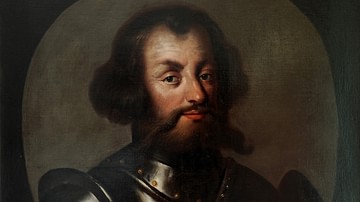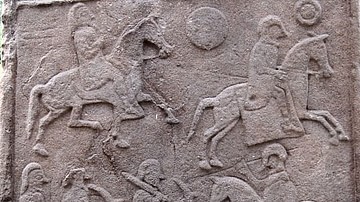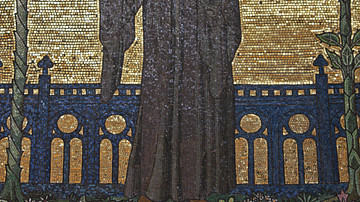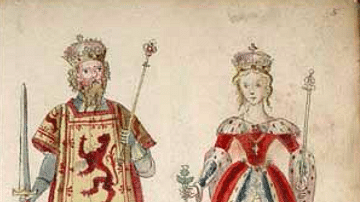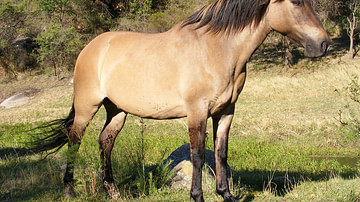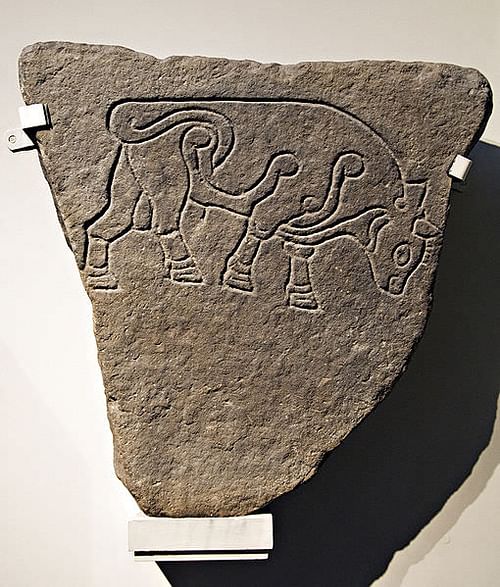
The Picts were a people of northern Scotland who are defined as a "confederation of tribal units whose political motivations derived from a need to ally against common enemies" (McHardy, 176). They were not a single tribe, nor necessarily a single people, although it is thought that they came originally from Scandinavia as a cohesive group. Since they left no written record of their history, what is known of them comes from later Roman and Scottish writers and from images the Picts themselves carved on stones. They are first mentioned as "Picts" by the Roman writer Eumenius in 297 CE, who referred to the tribes of Northern Britain as "Picti" ("the painted ones"), ostensibly because of their habit of painting their bodies with dye. This origin of their name has been contested by modern scholarship, however, and it is probable they referred to themselves as some form of "Pecht", the word for "the ancestors". They were referenced earlier by Tacitus who referred to them as "Caledonians" which was the name of only one tribe.
The Picts held their territory against the invading Romans in a number of engagements and, although they were defeated in battle, they won the war; Scotland holds the distinction of never falling to the invading armies of Rome, even though the Romans attempted conquest numerous times. The Picts exist in the written record from their first mention in 297 CE until c. 900 CE when no further mention is made of them. As modern scholars point out, their absence from written history does not mean that they mysteriously vanished or were conquered by the Scots and annihilated; it simply means no more was written about them as they merged with the southern Scots culture, who already had a written history by that time, and the two histories became one from then on.
Origins, Clans, & Name
Although it was accepted history in the past to date the arrival of the Picts in Scotland to sometime shortly before their mention in Roman history, or to claim a "Pictish Invasion", modern scholarship offers a much earlier date with no full-scale invasion. According to the Collins Encyclopedia of Scotland, "the Picts did not 'arrive' - in a sense they had always been there, for they were the descendants of the first people to inhabit what eventually became Scotland" (775). Historian Stuart McHardy supports this claim, writing that "the Picts were in fact the indigenous population of this part of the world" by the time the Romans arrived in Britain (32). They originally came from Scythia (Scandinavia), settled first in Orkney, and then migrated south. This claim is further supported by archaeologist and professor at Aberdeen University, Dr. Gordon Noble, who states, "All evidence points to the Picts being indigenous to northern Scotland...they began to coalesce during the late Roman period and formed some of the most powerful kingdoms in northern Britain in the early medieval period" (Wiener, 2). They lived in tightly-knit communities and built their homes out of wood, although their skill in stone carving is evident from the many engraved standing stones still extant throughout Scotland and housed in museums. These carved stone slabs are the only record the Picts left of their history; the rest of their story is told by later Roman, Scottish, and English writers.
McHardy credits the Picts with building the megalithic structures (such as the Ness of Brodgar), which can still be seen in Scotland in the present day (33). They established themselves in small communities made up of families belonging to a single clan which was presided over by a tribal chief. These clans were known as Caerini, Cornavii, Lugi, Smertae, Decantae, Carnonacae, Caledonii, Selgovae and Votadini (McHardy, 31). These clans (known as "kin") acted in their own interests, often raiding each other for cattle, but banded together when threatened by a common enemy and elected a single chief to lead the coalition. The kin (which comes from the Gaelic word for "children") would continue to follow and protect their chief, but that chief would obey the warrior all had agreed upon as group leader. Regarding the role of the chief, the historians Peter and Fiona Somerset Fry write:
The head of the kin was a very powerful man. He was looked upon as father of everyone in the kin, even though he might only be a distant cousin to most. He commanded their loyalty: he had proprietary rights over their land, their cattle; their possessions were in a sense his. His quarrels involved them and they had to take part in them, even to the point of laying down their lives (33).
This emphasis on the importance of family and a reverence for the father figure may actually be the origin for the name "Picts" as the people have come to be known. McHardy, and others, cites the word "Pecht" as "a general catch-all term for 'the ancestors' within Scotland" (36). McHardy and the other historians claim that the people of Northern Scotland referred to themselves as "Pecht", meaning both that they honored the ancestors and were themselves of ancient stock (i.e. the indigenous people of the land). McHardy cites the historian Nicolaisen who shows how "the Roman 'Picts' corresponds closely to the Old Norse Pettir and to the Old English Pehtas" and that these names, and others from the Anglo-Saxon Chronicle, "do not derive from each other but from a common source - probably a native name" (McHardy, 36). Given this, McHardy writes, "it is highly unlikely that [the Picts] were given their name by the Romans and therefore the idea of the term meaning 'the painted ones' has no basis in fact" (37). This claim, like many concerning the Picts, has been contested. Whatever they may have called themselves, and whatever it meant, the coalition of tribes ranged across the whole of Northern Scotland as far north as Orkney and as far south as the Firth of Forth. The males of the tribe were all warriors but, when not called upon to defend their clan or land, were farmers and fishermen and the females also farmed, fished, and raised the children. Aside from the occasional raids by one tribe against another for cattle, the Picts seem to have lived fairly peacefully until threatened by outside forces.

The Coming of Rome
Rome's first incursions into Britain were in 55 and 54 BCE by Julius Caesar but began effectively in 43 CE under Emperor Claudius. In 79/80 CE, Julius Agricola, the Roman governor of Britain, invaded Scotland and pressed on to a line between the rivers Clyde and Forth by 82 CE. After establishing fortifications, he invaded northern Scotland in 83 CE and was met by the Pictish leader Calgacus in battle at Mons Graupius. The historian Tacitus recorded the battle and, in so doing, was the first to give a written account of Scottish history. It is from Tacitus' account of the battle the oft-misquoted line, "they make a desert and call it peace" comes. The actual line as set down by Tacitus is, "They make a solitude and call it peace." Mons Graupius is an example of the Picts gathering together under a single leader to combat a common enemy. Tacitus does not call Calgacus a king nor a chief but writes, "One of the many leaders, named Calgacus, a man of outstanding valour and nobility, summoned the masses who were already thirsting for battle and addressed them" (McHardy, 28). Tacitus records that Calgacus had 30,000 men under his command whom he encouraged prior to the battle through his famous speech (which many historians claim is Tacitus' own creation). Calgacus began his address to his warriors thusly:
I have a sure confidence that this day, and this union of yours, will be the beginning of freedom to the whole of Britain. To all of us slavery is a thing unknown; there are no lands beyond us, and even the sea is not safe, menaced as we are by a Roman fleet. And thus in war and battle, in which the brave find glory, even the coward will find safety. Former contests, in which, with varying fortune, the Romans were resisted, still left in us a last hope of succour, inasmuch as being the most renowned nation of Britain, dwelling in the very heart of the country, and out of sight of the shores of the conquered, we could keep even our eyes unpolluted by the contagion of slavery. To us who dwell on the uttermost confines of the earth and of freedom, this remote sanctuary of Britain's glory has up to this time been a defence. Now, however, the furthest limits of Britain are thrown open, and the unknown always passes for the marvellous. But there are no tribes beyond us, nothing indeed but waves and rocks, and the yet more terrible Romans, from whose oppression escape is vainly sought by obedience and submission. Robbers of the world, having by their universal plunder exhausted the land, they rifle the deep. If the enemy be rich, they are rapacious; if he be poor, they lust for dominion; neither the east nor the west has been able to satisfy them. Alone among men they covet with equal eagerness poverty and riches. To robbery, slaughter, plunder, they give the lying name of empire; they make a solitude and call it peace (29-38).
Agricola faced the Picts with 11,000 soldiers of the 9th Legion and defeated them. The Picts attacked in the same form they would have grown accustomed to in tribal warfare, while the Romans held their position in strict formation and repulsed the charge, then counter-attacked. Tacitus writes, "the Britons, when they saw our ranks steady and firm and the pursuit beginning again, simply turned and ran. They no longer kept any formation or any touch with one another, but deliberately broke into small groups to reach their far and trackless retreats." McHardy notes, however, that what Tacitus perceived as a rout was actually a tactical maneuver. He writes how the Picts "had retreated back into the forests and mountains" and then goes on to note:
Tacitus presents this as a result of their defeat but another way of considering this is that they had gone back to their scattered communities to regroup. It is a telling fact that no other Roman source talks of a formal battle like Mons Graupius in the north during the rest of the period of Roman occupation of southern Britain. Although there were later major outbreaks of warfare like the Barbarian Conspiracy of 360, it would appear that the native warriors learned quickly that there was little use in fighting the disciplined Roman fighting machine in set battles, particularly when their own skills had been learned in the process of small-scale, fast-moving raids. The scattering referred to can be seen as the Caledonians reverting back to smaller-scale raiding groups after the battle. Something like modern guerilla warfare was clearly called for and would appear to have become the norm for the next 300 years (48).
Although the Romans won the battle, allegedly killing 10,000 Pictish warriors, they could not capitalize on this victory. Unlike other nations which the Romans invaded, the northern reaches of Britain had no central cities which could be conquered. McHardy notes that "By the time the Romans arrived in the northern half of the British Isles they had already overrun most of Europe and had developed a methodology of conquest and control. The lack of clearly defined central locales as seats of political power was perhaps part of the ongoing problem they had in trying to subdue this part of the world" (41). The Romans, in fact, never conquered the region which would become Scotland although they would make repeated attempts. The tribal nature of the Picts meant that they could move quickly from one locale to another, they were not tied to one single settlement in a geographical region, and they were adept at living off the land. The Romans, therefore, found themselves facing opponents who had no central cities to conquer, no farmlands to burn, and who, after Mons Graupius, refused to face them in the field as other peoples had done. The Picts were unconquerable because they presented the Romans with a new paradigm which Rome could not adapt to. The Roman legions had not yet encountered this kind of guerilla warfare (which would also prove effective in the Goth resistance under Athanaric to Roman invasion of their lands in 367-369 CE) and so were unable to subdue an enemy who lived, moved, and fought unlike any opponent they had faced before. The historians Peter and Fiona Somerset Fry write:
Tacitus described Mons Graupius as a great Roman victory; who can blame him. But was it? The fact remains that Agricola retired southwards when it was over. Moreover, when he left Britain a few months later, the frontier between the Romans and the Caledonians was nowhere near [the site of the battle]. It was more than 150 miles south, and over the years that followed, the Roman occupation of Scotland contracted and contracted. It probably never consisted of more than the holding of key forts and fortlets, and as time went by less and less of them (25).
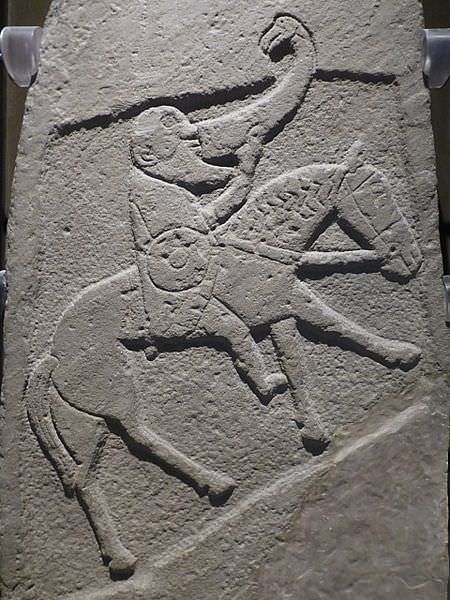
In 122 CE the emperor Hadrian ordered the construction of his famous wall which ran for 73 miles (120 km), sometimes at a height of 15 feet, from coast to coast. In 142 CE, the Antonine Wall was constructed further north under the reign of Antoninus Pius. These walls did nothing to discourage Pictish raids. The Frys note that "both Hadrian's and the Antonine Wall were psychological as well as physical barriers. They marked boundaries, as it were. But neither side for a moment imagined them to be impregnable. Perhaps the Romans did not even intend them to be" (27). The walls served as a demarcation line between the southern lands under Roman domination, which were considered "civilized", and the barbarian wilderness of the north which was controlled by the Picts. When the Romans left Britain in 410 CE, the Picts still lived in the regions north of the wall as they always had. Whatever effect the Roman presence may have had on them is unknown, but the carvings the Picts left on their standing stones show no major differences in lifestyle from before the arrival of Rome to after the departure of the legions.
The Coming of Christianity
During the time of the Roman occupation of Britain, the Roman Empire had adopted Christianity as the state religion, beginning with the emperor Constantine's decree of religious toleration, the Edict of Milan, in 314 CE. Christian missionaries began inroads into the lands of the Picts beginning with St. Ninian in c. 397 CE. The efforts of these missionaries, combined with the growing power in the south of the kingdom of Northumbria, would have lasting effects on the Picts. As McHardy observes, "Where the Roman Empire failed to conquer the Picts, the Christian Church succeeded" (93). The Picts practiced a tribal paganism which seems to have involved goddess worship and a devotion to nature which involved great respect for specific sites of supernatural power across the land where the goddess lived, walked, or had performed some kind of miracle. Women in Pictish society were regarded as the equal of men and succession in leadership (later kingship) was matrilineal (through the mother's side), with the reigning chief succeeded by either his brother or perhaps a nephew but not through patrilineal succession of father to son. There seems to be no record of the concept of "sin" in Pictish belief (the same as in other forms of paganism) and, as the goddess lived among the people, the land was to be venerated as one would the home of a deity. Christianity introduced a new paradigm of how the universe worked. McHardy writes:
The new religion brought in new concepts. The idea of an all powerful, often vengeful, male God was accompanied by the concept of all humans, and particularly women, as being essentially sinful. This, in a society where the likelihood was that women were at the very least equal to men, but where there was belief in a Mother Goddess, and possibly some sort of matriliny, suggests major change. There were other radical changes. The old goddess was within the landscape, the new God was in some unidentified stellar heaven. This would have to mean changes in people's perceptions of both themselves and the environment they inhabited (94).
While Ninian's efforts to convert the Picts had some effect, his later successor, St. Columba, would achieve major advancements in spreading Christianity. Ninian established Christianity among the southern Picts at some point in the reign of the Pictish king Drust I (also known as Drest I and Drust son of Irb) who ruled from either 406-451 CE or 424-451 CE (to name just two of the possible dates of his reign). Columba arrived from Ireland in c. 563 CE when the Pictish king Brude son of Mailcon ruled. Brude (also known as Brude I or Bridei) united the northern and southern Picts and, depending on which source one accepts, either became a Christian after meeting Columba or was already of the faith when Columba arrived.
A former tribal warlord in Ireland, Columba knew how to mobilize and inspire large groups of men and made use of this talent in his conversion of the Picts. It is from the time of Columba's missionary work around the Pictish stronghold of Inverness that the legend of the Loch Ness Monster derives. St. Adamnan, who wrote The Life of St. Columba, includes the story of a large monster who lived beneath the waters of the River Ness and had already eaten inhabitants of the region when Columba arrived. Columba rescued one of his companions from the monster by invoking the name of God and commanding the creature to depart at which point, "the monster was terrified, and fled more quickly than if it had been pulled back with ropes." This defeat of the monster is supposed to have greatly impressed the Picts who then converted to Christianity. Although the story deals with the River Ness, not the Lake Ness, it is considered the basis for all later stories about the Loch Ness Monster. Columba's other feats of wonder, including besting Pictish sorcerers at their own game (very like Moses with the Egyptian priests in the Book of Exodus) enhanced his reputation further and made Christianity a more attractive alternative to the traditional Pictish beliefs.
By the time Columba died in 597 CE, the Picts were mostly Christianized and had largely left their earlier way of life behind. The conversion of the Picts was not always a peaceful one, however. As late as 617 CE Picts were still resistant to the new religion, as evidenced by the martyrdom of Saint Donnan along with fifty-one of his followers by the Picts on the island of Eigg. Although records such as Adamnan's Life of Columba, or the works of Bede, present a narrative of Christian missionaries steadily, and successfully, advancing the faith, other works, such as the Annals of Ulster, make it clear that the conversion process did not go so smoothly. Even in 673 CE some segments of the Pictish population were still resistant to the new faith as evidenced by their burning of a monastery in Tiree.
Northumbria & the Battle of Dun Nechtain
The Picts' way of life was not only under assault by the Christian missionaries within their borders but also by a growing power to the south. The rise of the Anglican Kingdom of Northumbria, which made regular incursions into Pictish land, necessitated strong central leadership in the form of a king of all the tribes, instead of the old system of many tribal chiefs uniting for a time under the guidance of a single leader. Although it is unclear why the Picts felt the need for a central government, it is thought that they may have attributed the Northumbrians' effectiveness in conquest to their kings and so sought to protect their lands by employing the same system of government.
Northumbria had the resources and manpower to take large portions of land from tribes such as the Scots, who had arrived from Ireland and settled in Dalriada and Argyll, and the Britons of Strathclyde; both of whom were then subject to the Angles of the Kingdom of Northumbria. The Angles had also seized parts of the Pictish lands to the north, subjugating the people and installing kings whom they felt would serve their purposes. One of these Pictish kings was Bridei Mac Billi (better known as Brude Mac Bile) who is considered one of the greatest, if not the greatest, of the Pictish kings for halting the advance of the Angles of Northumbria and freeing his lands of their influence. In doing so, he would also remove the Northumbrian yoke from the Britons and the Scots to the south, as well as other tribes, and more or less set the early boundaries of what would later become England, Scotland, and Wales.
The Northumbrian king Ecgfrith, who was Brude's cousin, may have helped him to power on the condition that Brude would regularly send tribute and would work for Ecgfrith's interests. This claim has been contested, however, and it is also thought that Brude came to power after the Northumbrians defeated the king of the Northern Picts, Drest Mac Donuel at the Battle of Two Rivers in 670 CE. However Brude came to power, it is clear that he was expected to send tribute south to Northumbria. Brude, however, had no intention of doing so and, although it seems he initially did send tribute in the form of cattle and grain, this practice ended soon after he had consolidated his power. Ecgfrith was hardly pleased with this development but became more upset by Pictish raids into his kingdom south of Hadrian's now crumbling and undefended wall. Ecgfirth decided it was time to remove Brude and teach the Picts an important lesson but was advised to try diplomacy before battle.
At the same time, Brude was further consolidating his power by subduing rebellious Pict sub-chiefs. In 681 CE he took the stronghold of Dunottar and by 682 CE he had a navy of adequate size and strength to sail to Orkney and subdue the tribes there. Following this victory, he took the Scots' capital of Dunadd to the west so that, by 683 CE, he had secured his northern, eastern, and western boundaries (Orkney, Dunnotar, and Dunadd) and only had to concern himself with an attack directly from the south.
This attack came in May of 685 CE when Ecgfirth could no longer tolerate Brude's threats to his rule and refused the counsel of his advisors to try further diplomatic measures. He mobilized a force of cavalry (possibly numbering around 300) to put down what he saw as a Pictish rebellion in his lands. The Picts under Brude lured the Angle force deeper and deeper into their territory and then struck at a place known in English chronicles as Nechtansmere and in Welsh chronicles as Linn Garan; the Annals of Ulster refer to it as Dun Nechtain and this is the name most commonly referenced by historians. The Angle forces found themselves between the Pictish army, which is said to have numbered in the thousands, and the marshes of the lake. Ecgfirth, realizing his dangerous position, opted for a full-scale charge of his cavalry uphill to break the Picts' line in the center. Brude, however, fell back, feigning retreat, and then turned and held the line. He repulsed the charge, sending the Angles reeling in retreat back down the hill and toward the marshes; then, he counter-charged. The historian Bede, who gives the most detailed account of the battle, writes:
The enemy pretended to retreat and lured the king into narrow mountain passes, where he was killed with the greater part of his forces on the twentieth of May in his fortieth year and the fifteenth of his reign...Henceforward the hope and strength of the English realm began to waver and decline, for the Picts recovered their own lands that had been occupied by the English, while the Scots living in Britain and a proportion of the Britons themselves regained their freedom. Many of the English at this time were killed, enslaved, or forced to flee from Pictish territory. (McHardy, 124)
The Battle of Dun Nechtain broke Northumbria's power and secured the borders of the lands of the Picts which, later, would become Scotland. It also drove the Christian missionaries of the Angles out of Pictish lands which allowed for the original Columban brand of Christianity to take hold in the highlands instead of the Roman brand which had been accepted by the Angles. Brude continued to rule until his death in 693 CE; by which time his kingdom was secure and at peace. He was succeeded by an unpopular king, Taran, who was deposed after four years and succeeded by Brude Mac Derile who defeated another Anglican invading force in 698 CE and issued the famous decree, set down by St. Adamnan, known as the "Law of the Innocents" which set guidelines for the waging of war in order to protect women, children, clergy, and other non-combatants.
The Religious Wars & the Saltire
Brude Mac Derile died in 706 CE and was succeeded by his brother, Nechtan Mac Derile, who favored the Angles' version of Christianity over the Columban, or Celtic, church. The primary source of contention between the two was the dating of the celebration of Easter as well as secondary issues such as how the monks should wear their hair and conduct themselves. The more serious underlying issue, however, was that the Celtic church was locally based while the Anglicans had chosen to place themselves under the dictates of the Pope in Rome. This meant that the Celtic church owned its own lands while churches to the south were effectively owned and operated from Rome; priests in the land of the Picts came from the local community, those to the south were appointed by Roman Catholic authorities in Italy. It is not clear why Nechtan favored the Roman Catholic version of Christianity but, in 710 CE, he issued a royal decree to all the churches in his realm that they should accept the Roman Catholic dating of Easter and comply with Roman Catholic dictates in other regards.
This decree was seen by the Picts as a surrender to the Angles of the south, but they obeyed it, however reluctantly, until 724 CE when Nectan abdicated the crown in the face of growing hostility to his rule and retired to a monastery. As soon as he had left the throne, the land erupted in a civil war between adherents of the Celtic Church and those who had come to favor Roman Catholicism. For five years the land of the Picts was divided by almost daily conflict between these two sects but the fighting would actually last longer, until c. 734 CE, and none of the kings who followed Nechtan seemed to have the power to stop the killing. Finally, in 734 CE, Oengus son of Uurguist came to the throne and took control. It seems he was able to unite the Picts by focusing their hostilities against an enemy other than themselves or the Angles: the Scots of Dalriada. He invaded Dalriada in 734 CE and, in 736 CE, captured the citadel of Dunadd. The Scots were defeated and subjugated by 750 CE and Oengus then turned his attention to the Britons but was defeated at the Battle of Mocetauc.
Following Oengus, other kings ruled with more or less distinction until the rise of Constantin son of Fergus in 780 CE who consolidated the victories of Oengus into one kingdom under his rule. Constantin united the Picts and the Scots and was the first Scottish ruler to be known as Ard Righ -'High King' - of the Scots. When he died in 820 CE, his brother Angus son of Fergus took the throne. Angus is best known as the ruler who saw the vision of St. Andrew's cross in the sky, white clouds forming an `X' against the blue background, which would later come to be known as the Saltire, Scotland's flag. The Angles were again invading the land of the Scots and Picts and had gathered their forces at Mercia. The night before the battle, St. Andrew appeared to Angus in a dream and promised him victory in battle if the king would dedicate a tenth of his riches to the service of God. Angus agreed to this and, the next morning, the white cross appeared in the sky as confirmation of the deal. The Scots-Picts coalition defeated the English under Athelstan and Angus adopted the white `X' on a blue background as his standard.
Kenneth Mac Alpin & Unification
Although the Picts and the Scots had been joined under Constantin, history regularly credits this to the later king, Cinaed Mac Alpin, better known as Kenneth Mac Alpin. A popular story, long in circulation and still cited in history books, relates how Kenneth was a king of the Scots who, through intrigue and trickery, was welcomed by the court of the Pictish king and then murdered the royal family and seized the throne. Modern historians and scholarship reject this version of events completely. The original sources explicitly name Cinaed Mac Alpin as "king of the Picts", not of the Scots and his name is Pictish, not Scottish. The story of his "swindling or slaughtering the Picts all survive only in medieval manuscripts, with no earlier provenance" (McHardy, 167).
It is widely recognized today that Kenneth Mac Alpin was descended from King Aed Find of Scottish Dalriada and Constantin son of Fergus of the Picts; he was therefore an agreeable choice as king to both the Scots and the Picts. The claim that he wiped out the Pictish nation with a Scottish force after murdering the noble Pictish court is untenable. Firstly, there was no `Pictish Court' as it would have been imagined by later medieval writers and, secondly, as noted, Kenneth Mac Alpin had a legitimate claim to the throne of the Picts and would have had no need to exert force to claim the title of king. Kenneth Mac Alpin united the Picts and Scots more securely than Constantin, leading them in campaigns against the English to drive them completely from the region which would become Scotland. He came to the throne in 843 CE and, in eight years, extended his kingdom further than any other ruler of the region before him. By the time of his death in 858 CE, the borders of Scotland as a nation were recognizable in their present form and the English had been driven south into their own lands.
Besides the English encroachments, Kenneth Mac Alpin routinely had to fend off the increasing raids by Vikings who harassed the coast. He moved the relics of St. Columba from the holy island of Iona to Dunkeld (the new ecclesiastical seat), to secure them from Viking raids and is also credited with setting the Stone of Destiny at Scone as a symbol of national pride and power to inspire his people. After his death, the Viking raids continued and, as McHardy notes:
Many of these raids were extremely brutal. Surviving Annals from both Ireland and England tell of repeated raids year on year. The raids continued for much of the century and in time were accompanied by the Vikings settling. While many of the raids were carried out by handfuls of longships with up to a couple of hundred raiders, there were also some years when the Northmen arrived in much greater force. They were successful in taking over most of Scotland north of Inverness, the Hebrides and the northern isles of Orkney and Shetland, and they came close to totally conquering the Picts on at least one occasion. (161)
In response to the threat of the Viking invasions, the Picts and the Scots became even more unified. Giric, son of Donald Mac Alpin, Kenneth's brother, is the last ruler mentioned as 'king of the Picts' and, after his death c. 899 CE, the Picts are not mentioned in history again. McHardy writes: "the tribal peoples of Pictish and Scottish origin combined to form the new political entity of Alba which in turn became Scotland" (175). Dr. Gordon Noble supports this claim, stating there was "an increasing amalgamation of Picts and Scots - probably because of increasing Viking pressure on the native kingdoms of northern Britain" (Wiener, 3). The Picts of the ancient world did not disappear nor were they conquered and destroyed; they remained, the indigenous people of northern Scotland, and their descendants still walk their lands and fields in the present day.

